Table of Content
- Introduction
- The Challenges of Measuring Automotive Paint Thickness
- A Faster Way to Measure Automotive Paint Thickness
- Multilayer Thickness Measurement of Automotive Paint—An Example
- Learn More about Automotive Paint Thickness Measurements
Introduction
Automotive manufacturers continue to digitize and automate their operations to drive greater productivity and meet fast-changing customer demands, such as the adoption of electric, connected, and autonomous cars.
To support new developments, auto manufacturers must consider ways to streamline all their processes throughout production.
One example is automotive painting—a process that requires multiple layers of paint and Thickness Measurements.
Read on to learn about the challenges of measuring automotive paint thickness and how you can simplify this multilayered process with one thickness test.
The Challenges of Measuring Automotive Paint Thickness
Automotive paint is typically applied in four to five layers (or more) depending on the auto manufacturer and car color.
A car’s paint job generally includes an e-coat, primer, base coat, and clear coat on a metal substrate.
Some colors have an additional paint layer (mica).
Most current measurement options don’t let you see the individual layer thickness in one test.
Some NDT Methods require you to measure the total thickness after each paint layer is applied and manually subtract to get the individual layer thickness. This process is tedious and time-consuming.
Further, each car could have up to 100 or more NDT Inspection points depending on the make and model.
Layer thickness is usually measured in the same spots to monitor trends over time.
Car manufacturers can shorten the production time in the painting of cars by:
- Reducing the curing time between each paint application
- Measuring paint layer thickness after all paint layers have been applied—rather than after each paint application
This improved workflow requires a technology that can measure the individual layer thickness and the total paint layer thickness in one test at the end of the production line.
A Faster Way to Measure Automotive Paint Thickness
The 72DL PLUS™ ultrasonic thickness gauge is an ideal instrument for measuring automotive paint thickness as it provides high-speed and high-frequency measurements of up to six layers.
It also provides the individual layer measurements and the total thickness of the paint layers with one test.
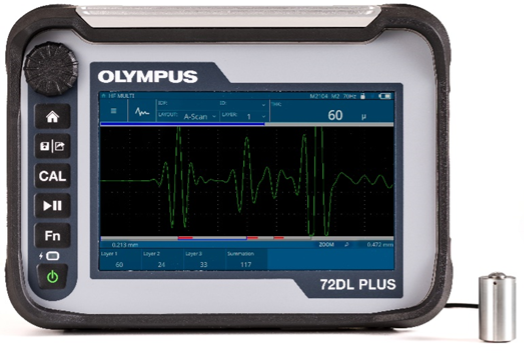
Its intuitive software makes paint thickness tests easier and faster.
For routine inspections, you can save a setup to recall it again.
Simply recall the setup from the gauge to start an inspection in just a few seconds!
Depending on your preference, you can set the unit of measurement on the gauge to mils, microns, or inches.
The M2104 (125 MHz) Ultrasonic Transducer is recommended for automotive paint thickness tests as it has a high enough frequency to measure multiple ultra-thin layers.
It also has three plastic discs that allow the transducer to be moved over the inspection part without abrading the painted sample.
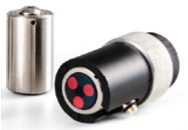
Multilayer Thickness Measurement of Automotive Paint—An Example
Here’s an example of a multilayer automotive paint application that has a clear coat, pigment, base coat, and primer.
The screenshot below is from the 72DL PLUS gauge (High-Frequency model).
It shows the paint layer thickness of four individual layers and the total thickness on the live inspection screen.
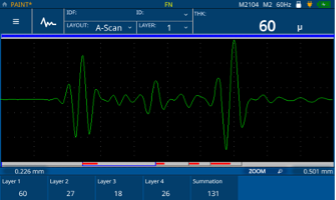
The 72DL PLUS gauge also offers five different layouts for data presentation - A-Scan, B-Scan, A/B-Scan, Trend, and Zoom—to help you better understand individual layer thicknesses.
The screenshots below show some of the ways you can visualize paint layer thickness on the gauge using these layouts.
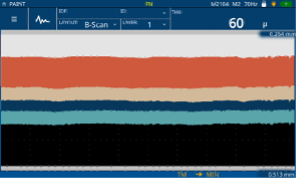
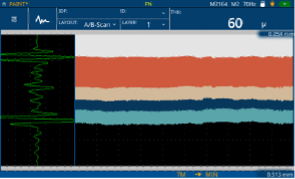
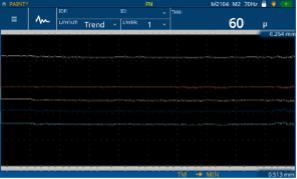
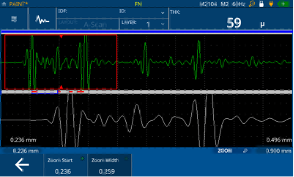
Another helpful feature is the guided inspection with a Custom part map.
This map shows an image of the inspection part with the inspection points clearly marked on the part.
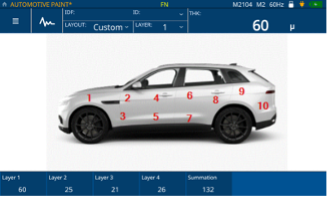
Learn More about Automotive Paint Thickness Measurements
Each multilayer paint application is unique and requires samples to be evaluated.
For more information or to request an evaluation of your automotive paint sample, reach out to us today. Our experts are happy to help.









